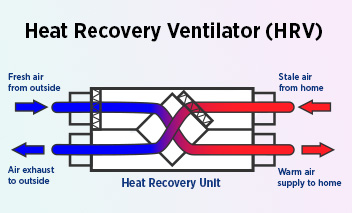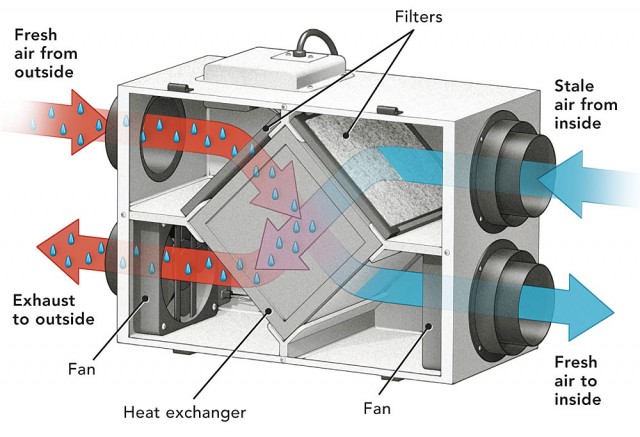Myths About HRV That Homeowners Should Avoid
Wiki Article
Revealing the Secret Perks and Uses of Heat Recovery Ventilation in Sustainable Design
Heat Recovery Ventilation (HRV) systems play a vital role in sustainable layout. They help with a constant exchange of stale indoor air with fresh outdoor air, significantly improving interior air high quality. Furthermore, HRVs add to energy efficiency by reclaiming warm from exhausted air, which can decrease energy expenses. Comprehending the diverse benefits and applications of HRVs exposes their value in modern-day design. What other benefits do these systems offer in the quest of sustainability?Recognizing Heat Recovery Ventilation Systems
Heat recovery ventilation (HRV) systems are made to improve indoor air quality while reducing power loss. These systems make use of a mechanical ventilation strategy to exchange stale interior air with fresh outside air, guaranteeing a continual supply of clean air. By capturing heat from the exhaust air, HRVs precondition inbound air, minimizing the demand on home heating and cooling down systems. This procedure not just boosts thermal convenience however additionally adds to energy performance in property and industrial buildings. In addition, HRV systems assist regulate moisture levels and lower interior contaminants, promoting a healthier living setting. Their strategic implementation is important for attaining lasting design objectives, as they provide an equilibrium between energy conservation and occupant health.Exactly How HRV Equipment Work
While many may be familiar with air flow systems, recognizing exactly how warmth recovery ventilation (HRV) systems run is essential for valuing their benefits. HRV systems work by exchanging stale interior air with fresh outdoor air while transferring warmth between both streams. This process happens in a warm exchanger, where warm from the outbound air warms the inbound air during cooler months, minimizing energy loss. On the other hand, in warmer months, the system can cool down incoming air utilizing the cooler outgoing air. HRVs are geared up with fans to facilitate air movement and filters to eliminate particulates, making certain a constant, balanced ventilation process. This ingenious style not just boosts energy performance but additionally adds to keeping a comfortable interior setting.Enhancing Indoor Air Top Quality
Indoor air top quality can considerably influence health and well-being, making reliable air flow necessary in modern-day homes. Heat Recovery Ventilation (HRV) systems play a vital role in preserving indoor air top quality by constantly trading stale interior air with fresh outside air. This procedure not just minimizes airborne pollutants however additionally lessens moisture degrees, which can cause mold and mildew development and respiratory system problems. HRV systems filter inbound air, eliminating allergens and particulates, therefore offering a healthier living setting. Additionally, these systems aid eliminate odors and unstable organic substances (VOCs) commonly found in home products. By making certain a consistent flow of tidy air, HRV systems add to a total improved indoor ambience, advertising convenience and well-being for owners.Energy Effectiveness and Price Savings
Energy effectiveness stands apart as a substantial benefit of Heat Recovery Ventilation (HRV) systems. By recording and reusing the warm from worn down indoor air, HRVs decrease the power required for heating incoming fresh air, bring about reduced power usage. This efficiency equates into lower energy bills, supplying substantial cost financial savings for property owners and companies alike. Furthermore, HRV systems typically get energy efficiency motivations and rebates, further boosting their monetary allure. Over time, the initial investment in HRV innovation can lead to a desirable roi with reduced energy costs. Consequently, the assimilation of HRV systems not only advertises lasting layout however also offers a sensible solution for attaining long-term power savings and economic benefits.Ecological Advantages of HRV

A wide variety of environmental benefits develops from the implementation of Heat Recovery Ventilation (HRV) systems. By successfully transferring warmth from exhaust air to incoming fresh air, HRVs considerably lower the power needed for home heating and cooling down areas. This power efficiency converts to lower greenhouse gas emissions, contributing to a decline in the general carbon footprint of buildings. In addition, HRV systems boost interior air quality by continuously circulating fresh air, consequently decreasing the concentration of interior contaminants and irritants. The reduction in power intake help in preserving all-natural sources, making HRVs an essential element of lasting layout. Generally, the ecological benefits of HRVs play a crucial role in advertising a much healthier earth and cultivating environment-friendly building practices.
Versatile Applications in Modern Architecture
Heat recovery ventilation (HRV) systems are increasingly being integrated right into both property and commercial architectural jobs. In household setups, HRVs enhance indoor air top quality while optimizing energy effectiveness. At the same time, in industrial areas, these systems maximize ventilation approaches, demonstrating their versatility in modern-day building applications.Residential Projects Combination
While modern style progressively stresses sustainability, the combination of warmth recovery air flow systems in property tasks has actually become a useful service for enhancing indoor air high quality and energy efficiency. These systems efficiently move warmth from exhaust air to inbound fresh air, decreasing power loss and minimizing heating or cooling down demands. In brand-new builds and retrofits alike, heat recovery ventilation can be seamlessly incorporated, giving house owners with a healthier living setting while reducing energy expenses. Additionally, with boosting awareness of environmental impacts, more architects and contractors are identifying the long-lasting advantages of these systems. Because of this, warmth recovery air flow has actually become a crucial component of sustainable property design, showcasing adaptability and dedication to green methods.Industrial Rooms Optimization
As contemporary business areas develop to fulfill the needs of sustainability and performance, the application of heat recuperation air flow systems arises as an essential technique for optimizing interior atmospheres. These systems help with the exchange of stagnant indoor air with fresh exterior air while recovering heat, significantly reducing power usage. This not only improves convenience for occupants but also aids in decreasing operational costs. Functional applications can be observed in offices, retail areas, and instructional organizations, where air top quality and temperature control are critical. Furthermore, incorporating warmth recovery air flow lines up with environment-friendly building certifications, further advertising environmental obligation. Ultimately, taking on such systems in commercial architecture not just contributes to sustainability goals yet also promotes much healthier, a lot more effective rooms for users.
Incorporating HRV Into Sustainable Design Practices
Integrating heat recuperation air flow (HRV) systems right into sustainable layout methods uses significant advantages in energy efficiency and interior air high quality. By using HRV, developers can develop affordable options that not just lower power consumption but also enhance the general convenience of indoor settings. This positioning with sustainability goals placements HRV as a vital element in modern-day architectural approaches.
Power Performance Improvement
By incorporating warmth recovery ventilation (HRV) systems right into lasting layout techniques, designers and contractors can substantially boost power effectiveness in contemporary building and constructions. HRV systems operate by capturing warmth from outward bound stagnant air and moving it to inbound fresh air, reducing the power needed for home heating or cooling indoor rooms. This process not only decreases reliance on typical a/c systems yet likewise reduces overall energy usage. Additionally, HRV systems can aid maintain a consistent interior temperature level, lowering peak energy needs. By incorporating these systems, buildings can achieve substantial decreases in utility expenses and carbon footprints, lining up with sustainability objectives. Eventually, HRV modern technology represents a sensible option for enhancing power efficiency in the constructed setting, advertising more accountable resource usage.Indoor Air Top Quality Renovation
Exactly how can heat healing ventilation (HRV) systems add to remarkable interior air quality in modern-day structures? HRV systems efficiently exchange stale indoor air with fresh exterior air while recouping warmth power, reducing temperature level changes. This process decreases the focus of interior pollutants, such as volatile organic substances (VOCs), irritants, and moisture, which can deteriorate air high quality and effect resident wellness. By maintaining suitable moisture levels and ensuring a continuous supply of clean air, HRVs help develop a healthier indoor environment. Additionally, these systems can be integrated right into lasting style practices, advertising power efficiency together with boosted air quality. HRV Heat Recovery Ventilation. HRV modern technology plays an important duty in progressing overall owner comfort and well-being in contemporary building styles.Economical Layout Solutions

Frequently Asked Questions
What Upkeep Is Needed for Heat Recovery Ventilation Solutions?

Maintenance for heat recovery ventilation systems normally entails normal filter substitutes, cleaning of warmth exchangers, inspection of fans and air ducts, and making certain correct drainage. These jobs assist preserve effectiveness and prolong the system's life expectancy in time.
Can HRV Solutions Be Set Up in Existing Structures?
Heat recovery ventilation systems can without a doubt be set up in existing buildings. HRV Heat Recovery Ventilation. Retrofitting requires careful planning and assessment of the building's design, ensuring compatibility with present systems while making the most of power efficiency and indoor air high qualityExactly How Do HRV Systems Impact Sound Degrees Inside Your Home?
HRV systems can influence indoor noise levels by presenting sound from outside sources with air flow. Top quality setups usually incorporate sound-dampening functions, lessening sound effect while providing effective air exchange and preserving comfort inside your home.Exist Any Downsides to Making Use Of HRV Equipments?
The drawbacks of utilizing HRV systems consist of potential high preliminary costs, maintenance challenges, and the possibility of decreased interior air high quality if filters are sporadically altered, which might cause concerns with moisture degrees.Exactly how Do I Pick the Right HRV System for My Requirements?
Selecting the ideal heat recuperation air flow system includes reviewing specific demands, such as developing size, environment, and power efficiency goals. In addition, assessing system attributes, installment HRV Heat Recovery Ventilation demands, and maintenance considerations is necessary for peak performance and fulfillment.Report this wiki page